
Rise of the Triad: Dark War is a first-person shooter video game, developed and published by Apogee Software in 1995. The player can choose one of five different characters to play as, each bearing unique attributes such as speed and endurance. The game's story follows these five characters who have been sent to investigate a deadly cult, and soon become aware of a deadly plot to destroy a nearby city. Its remake was designed by Interceptor Entertainment and released by Apogee Games in 2013. The shareware version of the game is titled Rise of the Triad: The HUNT Begins.
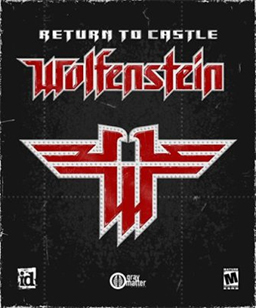
Return to Castle Wolfenstein is a first-person shooter video game published by Activision, released on November 20, 2001, for Microsoft Windows and subsequently for PlayStation 2, Xbox, Linux and Macintosh. The game serves as a reboot of the Wolfenstein series. It was developed by Gray Matter Studios and Nerve Software developed its multiplayer mode. id Software, the creators of Wolfenstein 3D, oversaw the development and were credited as executive producers. The multiplayer side eventually became the most popular part of the game, and was influential in the genre. Splash Damage created some of the maps for the Game of the Year edition. A sequel, titled Wolfenstein, was released on August 18, 2009.
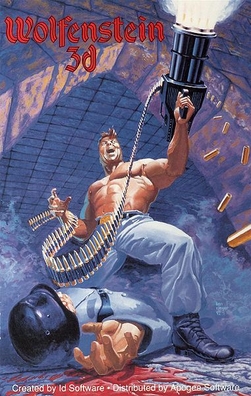
Wolfenstein 3D is a first-person shooter video game developed by id Software and published by Apogee Software and FormGen. Originally released on May 5, 1992, for DOS, it was inspired by the 1981 Muse Software video game Castle Wolfenstein, and is the third installment in the Wolfenstein series. In Wolfenstein 3D, the player assumes the role of Allied spy William "B.J." Blazkowicz during World War II as he escapes from the Nazi German prison Castle Wolfenstein and carries out a series of crucial missions against the Nazis. The player traverses each of the game's levels to find an elevator to the next level or kill a final boss, fighting Nazi soldiers, dogs, and other enemies with a knife and a variety of guns.

Rise of the Robots is a fighting game released by Time Warner Interactive in 1994. Originally developed for the Amiga and DOS by Mirage's Instinct Design, it was ported to various video game consoles, including the Super NES, the Mega Drive, and the 3DO Interactive Multiplayer. The game includes a single-player mode in which the player assumes the role of the ECO35-2 Cyborg as he attempts to stop the Supervisor who takes over Electrocorp's facilities in Metropolis 4, and a two-player mode in which the second player controls a character chosen from among EC035-2's enemies.
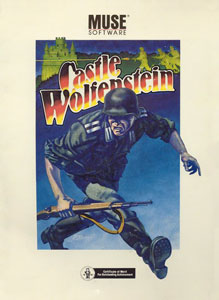
Castle Wolfenstein is a 1981 action-adventure game developed by Silas Warner for the Apple II and published by Muse Software in 1981. It is one of the earliest games based on stealth mechanics. A port to Atari 8-bit computers was released in 1982, followed by Commodore 64 (1983) and MS-DOS (1984). The player takes the role of an Allied prisoner of war during World War II who held captive in the fictional Castle Wolfenstein. After escaping from a cell, the player's objective is to find the Nazis' secret war plans and escape from the castle. Nazi soldiers can be dealt with via impersonation, sneaking, or killing.
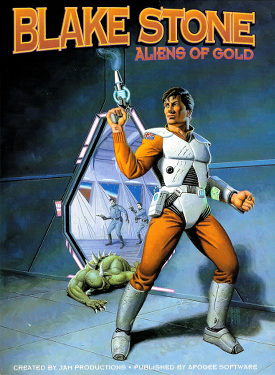
Blake Stone: Aliens of Gold is a first-person shooter for DOS created by JAM Productions and published by Apogee Software on December 5, 1993. The following year, a sequel called Blake Stone: Planet Strike was released, which continues where Aliens of Gold leaves off. Some copies of the game provided a Command Control Gravis Gamepad.
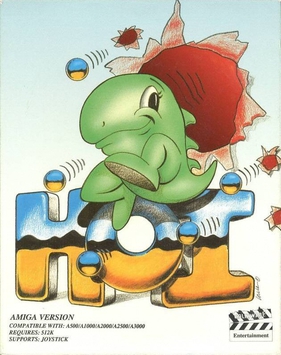
Hoi is a 1992 platform video game developed by Team Hoi and published by Hollyware Entertainment in North America and Software Business in Europe for the Amiga. In the game, players assume the role of the titular lime green "Saur" character venturing into the "Madlands", an area within Hoi's home planet populated with obstacles, to face a ritual test of maturity and find a female partner.

Walker is a horizontally scrolling shooter video game developed by DMA Design and published by Psygnosis for the Amiga in February 1993. The player controls a bipedal mech and is tasked with killing advancing enemies in stages set in multiple time periods. Development of the game began after the release of Blood Money, but was scrapped in 1990 because the game was not coming together. By the end of the year, development had recommenced with a redesign, inspired by sprites originally intended for Blood Money. Ian Dunlop and Neill Glancy designed the game, and Raymond Usher wrote its soundtrack. The game was released to positive reviews with praise directed at the game's graphics and sound, but reviewers were critical towards the repetitiveness of the gameplay. Amiga Power ranked it among their top 100 Amiga games of 1993.
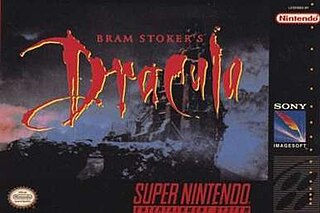
Bram Stoker's Dracula is a 1993 video game released for the Mega Drive/Genesis, Nintendo Entertainment System, Super NES, Game Boy, Master System, Sega CD, Game Gear, MS-DOS, and Amiga. It is based on the 1992 film Bram Stoker's Dracula which in turn is based on the 1897 novel Dracula by Bram Stoker. Most versions are platform games. The Sega CD and Amiga releases are beat 'em ups, and the MS-DOS version is a first-person shooter. The Amiga version was released in 1994 for North America and Europe. A CD-ROM version for MS-DOS compatible operating systems was released in 1995.
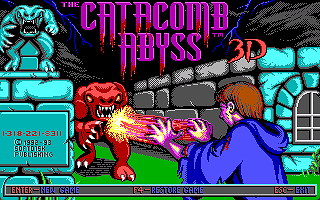
Catacomb Abyss is a fantasy themed first-person shooter (FPS) game developed by Softdisk and released in November 1992 for DOS. It is the fourth entry in the Catacomb series of video games. Its predecessor, Catacomb 3-D, was developed by id Software as part of a contract with Softdisk. When the contract ended, Softdisk kept ownership of both the 3D engine as well as the intellectual property of Catacomb 3-D. The company formed a new, in-house team to develop three sequels, known as the Catacomb Adventure Series. This trilogy consists of Catacomb Abyss, Catacomb Armageddon and Catacomb Apocalypse. Softdisk published a shareware version of Catacomb Abyss, which could be freely distributed and played to encourage gamers to purchase the full trilogy.

Alien Breed 3D is a first-person shooter, the fourth game in Team17's Alien Breed franchise, a series of science fiction-themed shooters. It was published in 1995 by Ocean Software. It was followed by a sequel, Alien Breed 3D II: The Killing Grounds, in 1996.

Alien Breed 3D II: The Killing Grounds is a first-person shooter game developed by Team17 for Amiga. Published by Ocean Software in 1996, it is the fifth game in the Alien Breed franchise, a series of science fiction-themed shooters.

The Addams Family is a platform game based on the 1991 film of the same name and developed and published by Ocean Software. It was released for home consoles such as the Super Nintendo Entertainment System, computers such as the Amiga, and handheld consoles like the Game Boy.
Wolfenstein is a series of alternate history World War II video games originally developed by Muse Software. The majority of the games follow William "B.J." Blazkowicz, an American Army captain, and his fight against the Axis powers. Earlier titles are centered around Nazi attempts to harness supernatural and occult forces, while later games are set after the Nazis successfully implement various science fiction technologies to achieve victory in World War II.

In video games, first-person is any graphical perspective rendered from the viewpoint of the player character, or from the inside of a device or vehicle controlled by the player character. It is one of two perspectives used in the vast majority of video games, with the other being third-person, the graphical perspective from outside of any character ; some games such as interactive fiction do not belong to either format.

A first-person shooter (FPS) is a video game centered on gun fighting and other weapon-based combat seen from a first-person perspective, with the player experiencing the action directly through the eyes of the main character. This genre shares multiple common traits with other shooter games, and in turn falls under the action games category. Since the genre's inception, advanced 3D and pseudo-3D graphics have proven fundamental to allow a reasonable level of immersion in the game world, and this type of game helped pushing technology progressively further, challenging hardware developers worldwide to introduce numerous innovations in the field of graphics processing units. Multiplayer gaming has been an integral part of the experience, and became even more prominent with the diffusion of internet connectivity in recent years.
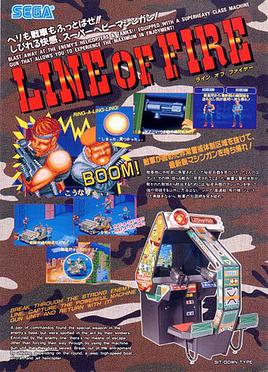
Line of Fire is a first-person light gun shooter game developed by Sega and released for arcades in 1989. It was released with two arcade cabinet versions, a standard upright and a sit-down cockpit, both featuring two positional guns. The cockpit design allows the player(s) to sit down while playing the game, while having two-handed machine guns, controlled by a potentiometer-controlled gun alignment software system. The game follows a two-man commando unit as they try to escape from a terrorist facility after seizing a prototype weapon.

Wolfenstein: The New Order is a 2014 action-adventure first-person shooter video game developed by MachineGames and published by Bethesda Softworks. It was released on 20 May 2014 for PlayStation 3, PlayStation 4, Windows, Xbox 360, and Xbox One. The game is the sixth main entry in the Wolfenstein series, set in an alternate history 1960s Europe where the Nazis won the Second World War. The story follows war veteran William "B.J." Blazkowicz and his efforts to stop the Nazis from ruling over the world.

Wolfenstein: The Old Blood is an action-adventure first-person shooter video game developed by MachineGames and published by Bethesda Softworks. It was released on 5 May 2015 for PlayStation 4, Windows, and Xbox One. The game is a stand-alone title in the Wolfenstein series and a prequel expansion to 2014's Wolfenstein: The New Order, set in an alternate-history 1946. The single-player story follows war veteran William "B.J." Blazkowicz and his efforts to discover the locations of a Nazi compound. Development began in 2014, soon after the release of The New Order.

Wolfenstein II: The New Colossus is a 2017 action-adventure and first-person shooter game developed by MachineGames and published by Bethesda Softworks. The seventh main entry in the Wolfenstein series and the sequel to 2014's Wolfenstein: The New Order, the game is set in an alternate history that takes place in 1961, following the Nazi victory in the Second World War. The story follows war veteran William "B.J." Blazkowicz and his efforts to fight against the Nazi regime in the United States. Gameplay mechanics are largely similar to those of The New Order, though the team introduced improvements such as allowing players to dual-wield any combination of weapons in the game. A binary choice in the prologue alters the game's entire storyline; some characters and small plot points are replaced throughout the timelines.



















